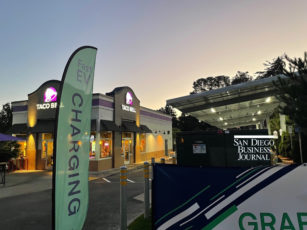Restaurants Can Monetize Their Parking Lots with Electric Vehicle Charging | QSR magazine
According to the Edison Electric Institute, the number of electric vehicles (EVs) on U.S. roads is projected to reach 18.7 million by 2030. More than 250,000 charging stations are needed to support this effort, which presents a serendipitous—and profitable—opportunity for restaurant operators.
EV drivers’ biggest problems are that charging stations are too far apart and take too long to fully charge their batteries. At the same time, restaurateurs are operating in a new environment that is less dependent on indoor dining and more focused on drive through and curbside pickup.
Cleantech company ChargeNet Stations offers a brilliant solution for brands looking to help pave the way for mainstream EV use. With the ChargeNet Stations system, drivers can locate restaurants with EV charging stations via an application on their phones and charge up while they wait for food.
“For EVs to sustain the growth we’ll see, charging must blend seamlessly with how consumers live their lives,” says ChargeNet Stations CEO Tosh Dutt. “Americans in every region and demographic eat fast food—it’s part of the culture—and just like fast food, EV charging must be quick, convenient, and deliver value.”
When drivers pull into a ChargeNet Stations-dedicated parking space, they can quickly and easily plug in their vehicle and order their favorite menu items via the restaurant’s app or a stationary digital screen. Or, once more restaurants reopen, customers will be able to charge their EVs while they dine inside.
ChargeNet Stations spaces sit under a solar array rooftop that provides shade and protection from the elements during inclement weather. Currently, the chargers provide roughly 100 miles of driving ability in 15 minutes—just enough time for restaurants to prepare and hand deliver a hot, fresh meal.
In addition to relieving the “range anxiety” that keeps many consumers from purchasing EVs, the ChargeNet Stations solution has several benefits for quick-serve operators.
“Our software consolidates data from a brand’s native app and POS to build an anonymized consumer profile for each EV driver,” Dutt says. “Based on past orders, operators can target promotions and obtain metrics around which menu items EV drivers order most.”
Some operators worry about long EV dwell times, but this is smartly managed with rapid recharging capabilities and carefully-targeted incentives.
“We monitor usage at all times,” says ChargeNet Stations CTO Rebecca Wolkoff. “At high usage, we can incentivize customers to leave and open that spot for others by offering a cheaper rate. Conversely, at low usage we can encourage customers to linger, which can help spread guest traffic across other dayparts.”
Operators can also save 20–40 percent on their restaurants’ electricity by consuming the energy produced by the solar panels and stored in the battery system. During power outages or natural disasters, restaurants can have the ability to use this stored energy to continue operations. No maintenance is required by the operator—if a charger or solar panel malfunctions or needs to be replaced, a service provider is dispatched the same day. EV chargers also ease the energy burden placed on utility companies and showcase a brand’s commitment to sustainability.
Turning unused parking spaces into charging stations can please consumers, increase profits, and help the environment—a win-win for all stakeholders.


